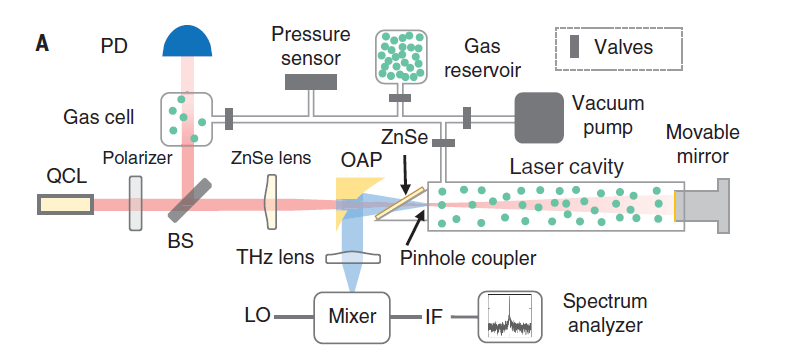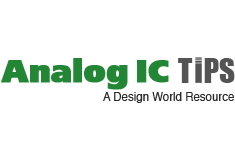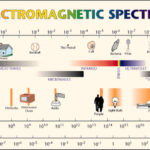The terahertz part of the electromagnetic spectrum between millimeter waves and optical range remains a largely untapped, difficult-to-use resource; researchers are investigating different techniques for efficiently generating terahertz waves to promote the use of this part of the spectrum.
Approach #3: Laughing Gas
A team at MIT in close collaboration with one at nearby Harvard University has developed a laser-pumped, gas-based terahertz source which can be fine-tuned over 37 lines spanning 0.251 to 0.955 THz, each with kilohertz linewidths and power greater than 1 milliwatt.
The underlying physics is obviously extremely sophisticated, based on what is called rotational population inversions, which are optically pumped by a quantum cascade laser (QCL). Also fascinating is that the gas they used for a variety of reasons was nitrous oxide, better known as laughing gas.
Their implementation overcame some previously assumed theoretical limitations about cavity size as well as molecular interaction and collision. This analysis led to the development of a new mathematical theory to describe the behavior of a gas in a molecular gas laser cavity. Their latest model tracked thousands of relevant vibrational and rotational states among millions of groups of molecules within a single cavity, using new numerical analysis and computational techniques to reduce the large problem and make it solvable on a laptop computer. It then analyzed how those molecules would react to incoming infrared light, depending on their position and direction within the cavity.
The entire project used off-the-shelf standard electro-optical components, including a custom-built tunable QCL (also constructed from standard parts) developed by the Harvard group. This QCL provided the power that the MIT group’s theory predicted would be needed to properly excite a resonant cavity the size of a pen (a conventional cavity is about 1000× larger). The researchers then looked through libraries of gases to identify those that were known to rotate in a certain way in response to infrared light and selected nitrous oxide.
Although the principles, design, and implementation are extremely advanced, a few figures summarize the situation. In the arrangement (Figure 1), IR light from a widely tunable QCL is tuned to pump a “rotational (ro)-vibrational” transition and create a rotational population inversion. Light from the QCL is deflected by a 90%–10% beam splitter (BS) and transmitted through a gas cell so that the QCL may be tuned into coincidence with the vibrational transition by minimizing the transmitted intensity measured using a photodiode (PD). Light is coupled into the laser cavity through a zinc selenide (ZnSe) window at Brewster’s angle and through a pinhole coupler in the cavity. A vacuum pump, pressure sensor, and gas reservoir are used to set the pressure in both the laser cavity and gas cell.

The radiation emitted from the pinhole of the QPML is collected with the off-axis parabolic mirror (OAP), focused through a Teflon lens, and measured by a power meter, a detector, or a receiver that uses a frequency-multiplied local oscillator (LO) mixed with the signal to produce the intermediate frequency (IF) measured by a spectrum analyzer. The pump power from the QCL is varied using a wire grid polarizer on a calcium fluoride substrate. The laser cavity is tuned into resonance with the lasing frequency by moving a copper mirror on a translation stage; (Figure 2) shows the tuning range.

Full details are in their published paper with a deceptively short and simple title “Widely tunable compact terahertz gas lasers” published in AAAS Science; an unlocked version along with extensive Supplementary Materials is posted here. Note that although the paper’s authors use the word “simple” quite often for both the theoretical underpinnings and the physical implementation, none of it is simple in any way.
Although there are many obstacles to the efficient generation and control of terahertz waves as well as their productive use, the history of technology advances teaches us to “never say ‘never’. “ Will this eventually be the case for electromagnetic energy in the THz spectrum via simple, cost- and energy-effective sources comparable to laser diodes and photo- or power-sensitive detectors? Only time will tell.
Additional Part 4 Resources
MIT, “Researchers generate terahertz laser with laughing gas”
Harvard University, “New laser opens up large, underused region of the electromagnetic spectrum
Terahertz Perspectives
IEEE Spectrum, “Wireless Industry’s Newest Gambit: Terahertz Communication Bands”
IEEE Spectrum, “Terahertz Waves Could Push 5G to 6G”
IEEE Spectrum, “The Truth About Terahertz”
EE World Online References
Terahertz Laser Pulses Amplify Optical Phonons in Solids
Terahertz Technology Creates New Insight Into How Semiconductor Lasers Work
Scientists Fine-Tune Carbon Nanotubes For Flexible, Fingertip-Wearable Terahertz Imagers
The Future Of Wireless Communications Is Terahertz
Bridging The Terahertz Gap
Inspecting Matter Using Terahertz Light
Graphene And Terahertz Waves Could Lead The Way To Future Communication
Wave of the Future: Terahertz Chips a New Way of Seeing Through Matter
Terahertz Wireless Could Make Spaceborne Satellite Links as Fast as Fiber-Optic Links
NUS Engineers Develop Low-Cost, Flexible Terahertz Radiation Source for Fast, Non-Invasive Screening
Researchers Whip Up Terahertz Radiation at Room Temperature
Light-powered 3-D Printer Creates Terahertz Lens




